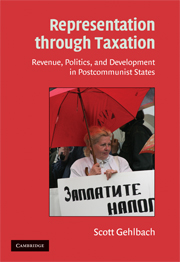Book contents
- Frontmatter
- Contents
- List of Tables
- List of Figures
- Acknowledgments
- Note on Transliteration
- 1 TAXES, REPRESENTATION, AND ECONOMIC DEVELOPMENT IN THE RUSSIAN HEARTLAND
- 2 THE CREATION OF TAX SYSTEMS
- 3 THE LOGIC OF REPRESENTATION THROUGH TAXATION
- 4 PATTERNS OF COLLECTIVE-GOODS PROVISION
- 5 REVENUE TRAPS
- 6 CONCLUSIONS
- Bibliography
- Author Index
- Subject Index
- Titles in the series
4 - PATTERNS OF COLLECTIVE-GOODS PROVISION
Published online by Cambridge University Press: 31 August 2009
- Frontmatter
- Contents
- List of Tables
- List of Figures
- Acknowledgments
- Note on Transliteration
- 1 TAXES, REPRESENTATION, AND ECONOMIC DEVELOPMENT IN THE RUSSIAN HEARTLAND
- 2 THE CREATION OF TAX SYSTEMS
- 3 THE LOGIC OF REPRESENTATION THROUGH TAXATION
- 4 PATTERNS OF COLLECTIVE-GOODS PROVISION
- 5 REVENUE TRAPS
- 6 CONCLUSIONS
- Bibliography
- Author Index
- Subject Index
- Titles in the series
Summary
In Chapter 2, I showed how two very different tax systems took shape in the postcommunist world during the 1990s. In the former Soviet Union, various structural characteristics — highly concentrated industrial structures, distance from the West and the pull of the European Union, and relatively low levels of economic development — encouraged states to rely on corporate taxes and taxes on goods and services, both key Soviet-era revenue sources. In Eastern Europe, in contrast, there was greater emphasis on taxation of individuals, a revenue source not central under communism. 1 Such differences were reflected in patterns of tax compliance, as tax authorities concentrated to a greater or lesser degree on collecting taxes from revenue sources with which they were familiar. In the former Soviet Union, the heavy emphasis on taxation of large, often monopolistic, enterprises of the sort that populated the Soviet economic landscape left other firms comparatively free to hide revenues from tax authorities. Meanwhile, in Eastern Europe, the revenue net was cast more widely, resulting in smaller systematic differences in tax compliance across economic sectors.
The model in Chapter 3 helps us to predict the consequences of these patterns of revenue collection and tax compliance for provision of sectors-pecific collective goods. Generally speaking, we should expect politicians in the former Soviet Union to have been more inclined than their counterparts in Eastern Europe to promote sectors that were relatively easy to tax.
- Type
- Chapter
- Information
- Representation through TaxationRevenue, Politics, and Development in Postcommunist States, pp. 86 - 126Publisher: Cambridge University PressPrint publication year: 2008

